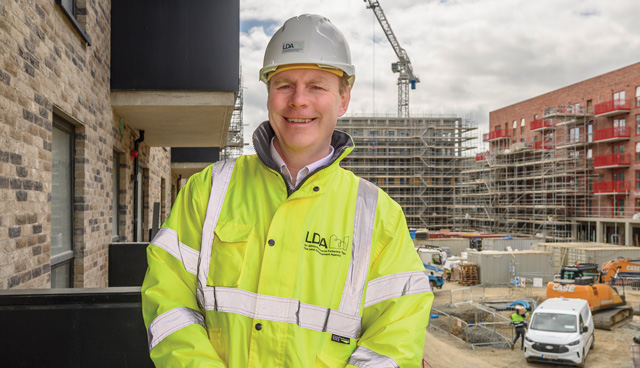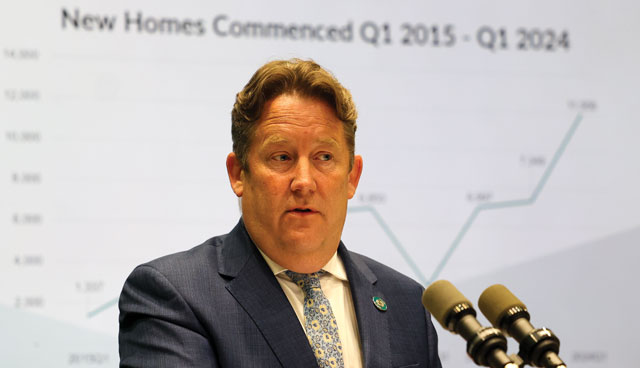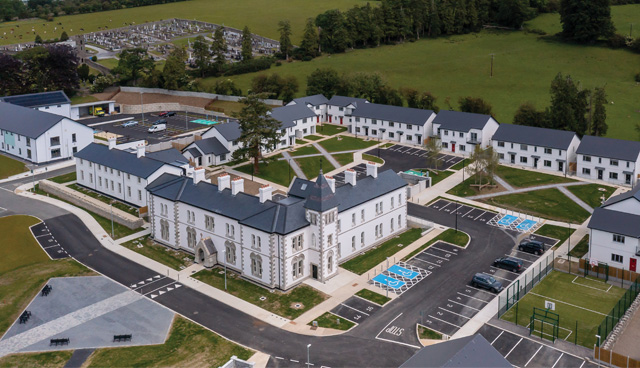
Continued expansion of AHB sector in 2023
3rd July 2024
Latent defects in newly built homes
3rd July 2024Designing for affordable housing and sustainable communities

Principal Architectural Advisor and Head of the Strategic Delivery and Urban Advisory Unit in the Affordable Housing Division of the Department of Housing, Local Government and Heritage, Martin Colreavy, discusses the importance of a plan-and-design-led process for the delivery of affordable housing.
Describing the on-going challenges of climate change as the “ultimate sustainability project” for the Department, Colreavy says that sustainable residential development and compact growth are the apex of the solution, both nationally, and across Europe.
Project Ireland 2040 – encompassing the National Development Plan (NDP) and the National Planning Framework (NPF) – serves as the guiding policy framework for compact growth, with a particular focus on brownfield development.
Underpinning this, Housing for All, the Government’s housing plan to 2030, has an overarching objective of providing every citizen access to good quality homes, which can be rented or purchased at an affordable price, built to a high standard in the right place, and offer a high quality of life.
Housing for All outlines four pathways to a more sustainable housing system.
• Pathway 1: Increasing affordability/home ownership;
• Pathway 2: Eradicating homelessness/improving social housing delivery;
• Pathway 3: Increasing new housing supply via mechanisms such as land value sharing, urban development zones, and the Croí Cónaithe (Cities) Scheme;
• Pathway 4: Vacancy and existing stock (Towns Centre First/Croí Cónaithe Towns).
Colreavy’s work mainly centres on Pathway 1 and affordability, but he emphasises that within the Department’s affordable housing division, there are correlating functions beyond this pathway that also focus on affordability, such as vacancy, viability funds, and mechanisms to increase overall residential supply, for example.
Articulating the vision of the Department, Colreavy echoes the words of Minister for Housing Darragh O’Brien TD that it wants to avoid certain unsustainable settlement patterns of the past and move towards more compact and sustainable growth.
On successes to date, he insists that current progress has not happened by accident, and points to a long tradition in Ireland of looking outwards towards European counterparts. Citing the regeneration of the Hamburg docklands in Germany, and the Hammarby Sjöstad regeneration project in Stockholm, Sweden, as exemplars of housing sustainability during the early 2000s, he says: “At the same time we were investing in this consideration of quality and design through policies around urban design, adaptive reuse, and how sustainable mixed use neighbourhoods work.
“We developed and refined guidelines over and after the noughties, and more recently, we have invested in thinking again around the second iteration of quality housing through the Sustainable Residential Development and Compact Settlements Guidelines for Planning Authorities, and our own examination of affordable delivery best practice.”
Three years into its existence, Colreavy says that his division – led by Assistant Secretary Caroline Timmons – is extremely active, particularly in larger strategic development areas such as Clonburris and Cherrywood in Dublin, and Cork City Docklands.
“The scale of those projects provides certainty of pipeline. They provide a certainty of master planning approach where we can address blended investment.”
Colreavy explains that this master planning has also been key to unlocking private sector investment and leveraging public funds for other projects of either a medium-large scale in nature.
Outlining work with a multitude of delivery partners across the affordable housing sector, he believes that the Department is making a difference on sustainable communities and by extension, tenure mix.
Colreavy commends The Housing Agency’s Social, Affordable, and Co-operative Housing in Europe 2020 publication, which offered an assessment of how other countries were dealing with brownfield development and infill viability challenges, will ensuring that similar projects become more realisable in Ireland.
In response, and as part of Housing for All Action 32, the Department, alongside The Housing Agency, commissioned Bucholz McEvoy Architects to assess 12 of its funded affordable purchase and cost rental schemes across the country. This published case example work was concluded and titled Examination of innovation/efficiencies in design of affordable housing1. The purpose of this publication was to highlight how quality affordable housing can be most effectively delivered by demonstrating innovation and efficiencies in construction and design on existing projects to inform future approaches.
“Based on that, we have looked at the process of pipelining and how projects get delivered conceptually through the cost modelling, if it is cost rental, or through affordable purchase, in terms of viability to the completion stage.
“It has afforded us an opportunity to take a step back and assess the affordability schemes we are involved with nationally.”
Concluding, Colreavy says: “What we have determined from that process is that a strategic plan-and-design-led approach to housing is critical, based on an acute analysis of the local challenges and a tailored response to match. This moves away from the more routine or formulaic approach and creates a value added ‘vision’ factor.
“We have also learnt that a strong local governance approach or a dedicated champion is essential, normally comprising a multi-disciplinary team who understand the planning and design considerations of the place but who are informed by community stakeholders.
“In any housing strategy – but for affordable delivery in particular – the business case is essential. It must be comprehensive and examine both the risks and opportunities of schemes in terms of viability, cost benefit, and in some cases long-term commerciality.
“Finally, those components will not land unless there is a good delivery strategy. The methodology of implementation must be comprehensive and concise, ensuring the deliverability of the various schemes are achievable in both the short and long term.”
1. www.housingagency.ie/publications/examination-innovation-efficiencies-design-affordable-housing







